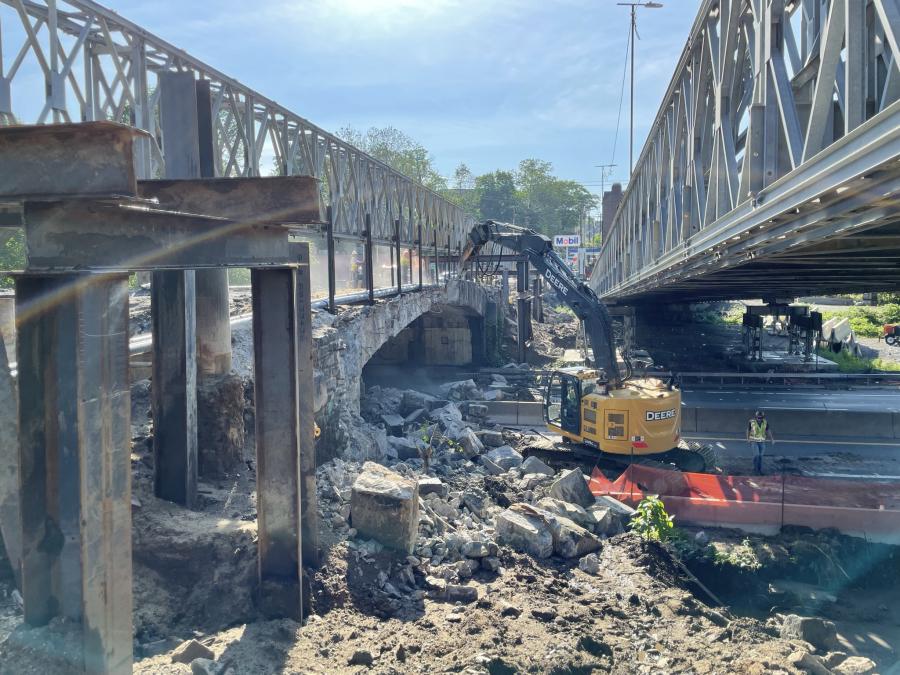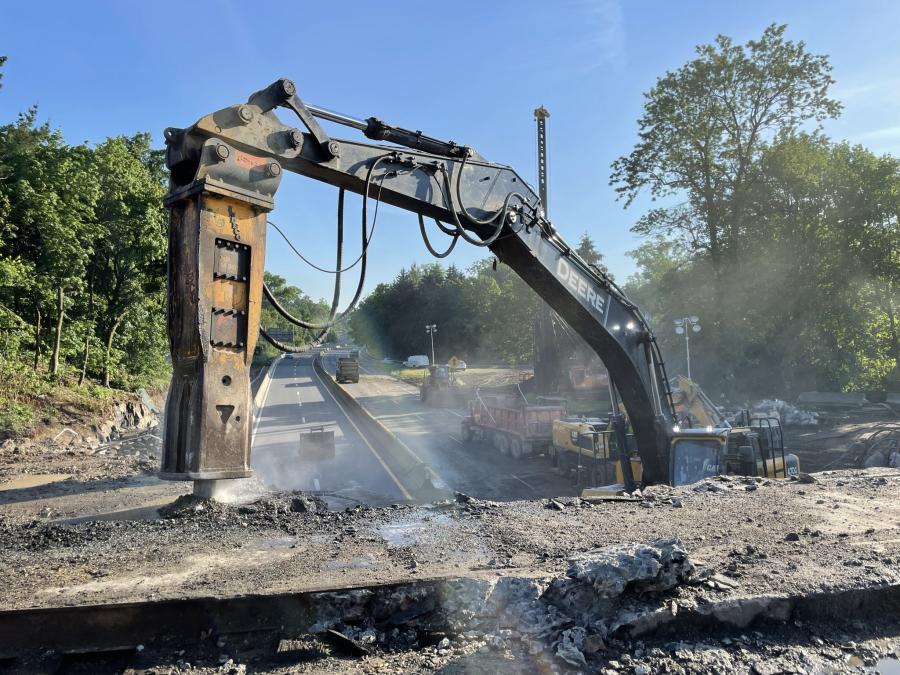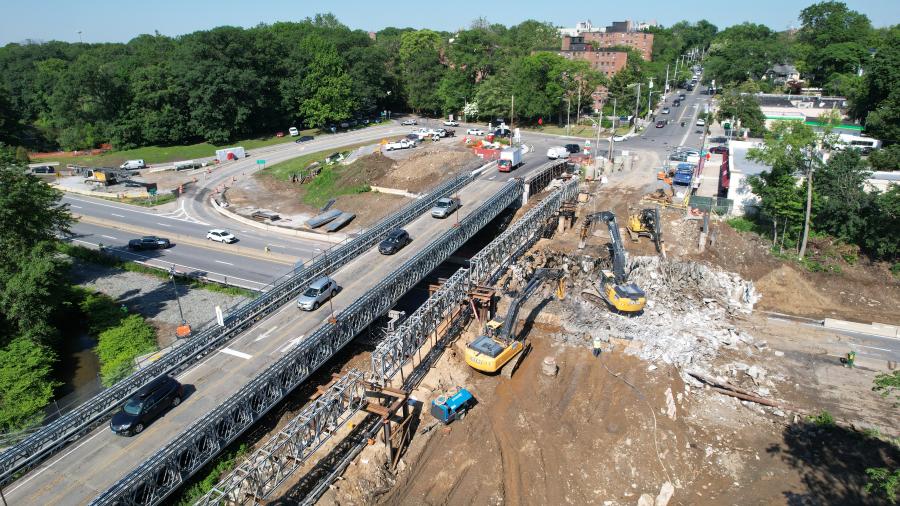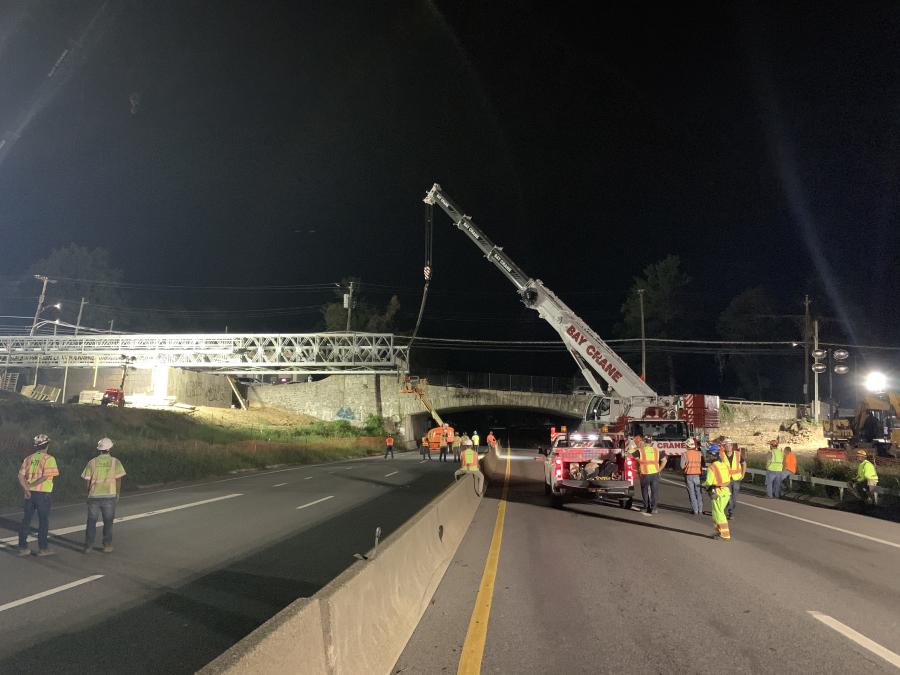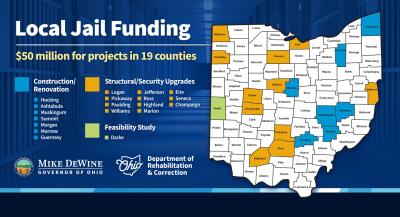John Deere 345 excavators with hammers were used to demolish the Hutchinson River Parkway, which was completed over a weekend.
(Photo courtesy of Halmar International.)
Halmar International LLC is hard at work for the New York State Department of Transportation's (NYSDOT) $115 million Lower Westchester Bridge Bundle, which has been divided into three projects — one that has been completed and two that are ongoing.
"The NYSDOT has initiated a multi-faceted project in Westchester County, which includes the East Lincoln Avenue bridge in Pelham and Mount Vernon, Saw Mill River Parkway bridges over the Saw Mill River, and the U.S. Route 1 bridge over Mamaroneck River in Mamaroneck," according to NYSDOT. "The project, which includes drainage improvements and the reconstruction of roadways prone to flooding, will enhance safety and improve the region's resiliency during storm events."
The $48 million East Lincoln Avenue project started in summer 2020 and was completed two years later. This work replaced two bridges and a large culvert at East Lincoln Avenue, over the Hutchinson River Parkway and Hutchinson River in Pelham and Mount Vernon. A temporary bridge carried traffic during construction. The Hutchinson River Parkway stormwater system also was replaced and flood walls were installed, along with a bypass culvert to convey precipitation from storm events into Pelham Lake.
The two bridges, constructed in 1925, were replaced with a single, two-span bridge that features an additional 3 ft. of clearance to help reduce collisions with over-height vehicles, and included the replacement of the bridge's approach slabs.
The bypass culvert installation that carries the northbound Hutchinson River Parkway off-ramp over the Hutchinson River was a critical element of the work.
"It will improve water flow and help reduce instances of flooding at this location," said Heather M. Pillsworth, NYSDOT public information officer for the Hudson Valley Region. "Additionally, the Hutchinson River Parkway at East Lincoln Ave. was reconstructed to better withstand severe weather events. With new traffic signals and bridge rail, this wider, pedestrian-friendly bridge links residents and businesses along East Lincoln Ave. for daily commerce, work and school. While construction was ongoing, a temporary bridge was in place adjacent to the new bridge structure to maintain the flow of traffic. [The project] enhances safety, mobility and resiliency along a heavily traveled corridor that links the village of Pelham and city of Mount Vernon."
The Saw Mill River Parkway project is proceeding. This work has new bridges being constructed on Saw Mill River Parkway over the Saw Mill River being elevated to meet 100-year flood projections and a 1.3-mi. stretch of roadway being stabilized to divert water from the road and mitigate settling. Saw Mill was reopened to two lanes of traffic in both directions in October.
The U.S. Route 1 project is replacing the U.S. Route 1 stone arch bridge over the Mamaroneck River. The work includes removing and replacing the structure supporting part of Meighan Park at the southeast corner of U.S. Route 1 and Mamaroneck Avenue, with the park to be reconstructed. For this project, two lanes of traffic in each direction will be maintained throughout construction.
On Nov. 21, NYSDOT Commissioner Marie Therese Dominguez announced the completion of several bridge projects totaling $60.5 million, including the bridge carrying East Lincoln Avenue over the Hutchinson River Parkway and Hutchinson River.
The East Lincoln Avenue project was designed by McLaren Engineering Group.
"Maintaining open parkways during construction [was an issue that had to be dealt with]," said an NYSDOT team overseeing the project. "The lifespan of the new bridge and infrastructure is 75-plus years."
The project required careful planning and coordination.
"Doing major construction, including the installation of 5,000 timber piles and the relocation of utility lines, while minimizing traffic disruptions was a challenge," said the NYSDOT team, which noted that this was a tight work zone. "One of the goals of the project was to reduce instances of flooding and raise a portion of the Saw Mill River Parkway above, which required the installation of 5,000 timber support piles. The project also required the relocations of some major utility lines. Crews worked throughout the winter, including weekends. Nighttime operations were limited due to the proximity to residential homes."
The temporary bridge, which carried two vehicular lanes and a temporary sidewalk, was installed in four weeks and upon completion of the new bridge, removed in three weeks.
"The bridge was assembled on the ground on large rollers and then moved across the Hutchinson River Parkway by a large dozer and a crane until it rested on the other side on temporary footings and towers," according to NYSDOT.
The bridge over the Hutchinson River Parkway was demolished in one full weekend with a full closure of the parkway.
"The masonry bridges consisted of concrete and stone," said NYSDOT. "Doing major construction, including the relocation of utility lines, while minimizing traffic disruptions was a challenge during the demolition. A demo tarp was installed to collect slurry."
The demolition process had crews using a Liebherr 1250 hydraulic crane for demolition, two John Deere 345 excavators with hammers, a Komatsu 228 excavator with a hammer, a Caterpillar 322 excavator and a Caterpillar 950 loader.
The single, two-span bridge was constructed between June 2021 and April 2022.
"The new 248 linear foot-long bridge has one lane in each direction, with parking spaces and turning lanes at each end," said NYSDOT. "The bridge is concrete on a metal deck, supported by nine girders running between two footings and a center pier. The challenges included installation of piles and excavation of footings in close proximity to the parkway and due to the high water table."
Temporary timber shielding was utilized to prevent debris from falling. Equipment-wise, a Liebherr 1225 crane for girder installation was brought in, as well as Junttan PM 20 and 25 pile rigs.
The replacement of the Hutchinson River Parkway stormwater system and installation of the flood walls occurred throughout the project.
"Small areas were cordoned off and excavated under live traffic," according to NYSDOT. "Flood walls and berms were installed off the parkway along the existing river that ran parallel to the parkway. Challenges included deep excavation adjacent to live traffic."
Komatsu 228 and Caterpillar 322 excavators were employed for this aspect of the work.
The bypass culvert was constructed between fall 2020 and spring 2021.
"The area was excavated using a slide rail support of excavation system," according to NYSDOT. "Large precast sections were installed along the existing parkway. Deep excavation adjacent to live traffic was a challenge."
For this aspect of the project, a John Deere 470 excavator was key.
Asphalt millings from the project (40,000 tons) were all recycled, as well as the material excavated from the box culvert and drainage excavations (20,000 tons). The amounts of new materials used for the bridge construction have not been finalized.
Local and regional subcontractors are engaged in the project.
Halmar International purchases and rents equipment from local and regional dealerships. Cranes from Bay Cranes were on site. CEG
Irwin Rapoport
A journalist who started his career at a weekly community newspaper, Irwin Rapoport has written about construction and architecture for more than 15 years, as well as a variety of other subjects, such as recycling, environmental issues, business supply chains, property development, pulp and paper, agriculture, solar power and energy, and education. Getting the story right and illustrating the hard work and professionalism that goes into completing road, bridge, and building projects is important to him. A key element of his construction articles is to provide readers with an opportunity to see how general contractors and departments of transportation complete their projects and address challenges so that lessons learned can be shared with a wider audience.
Rapoport has a BA in History and a Minor in Political Science from Concordia University. His hobbies include hiking, birding, cycling, reading, going to concerts and plays, hanging out with friends and family, and architecture. He is keen to one day write an MA thesis on military and economic planning by the Great Powers prior to the start of the First World War.
Read more from Irwin Rapoport here.
Today's top stories



